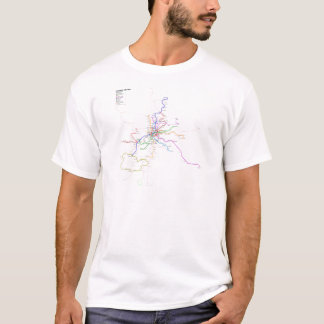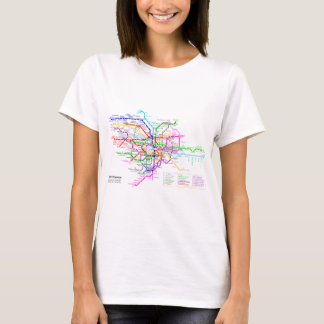About
Zazzle gifts related to world Metro Maps. Rapid transit is a type of high-capacity public transport generally found in urban areas. Unlike buses and trams, rapid transit systems operate on an exclusive right-of-way which is usually grade separated in tunnels or elevated railways.
Modern services on rapid transit systems are provided on designated lines between stations typically using electric multiple units on rail tracks, although some systems use guided rubber tyres, magnetic levitation, or monorail. The stations typically have high platforms, without steps inside the trains, requiring custom-made trains in order to avoid gaps. They are typically integrated with other public transport and often operated by the same public transport authorities, but does not exclude a fully segregated light rail transit. It is unchallenged in its ability to transport large amounts of people quickly over short distances with little use of land. Variations of rapid transit include people movers, small-scale light metro, and the commuter rail hybrid S-Bahn.
The first rapid-transit system was the partially underground Metropolitan Railway which opened in 1863, and now forms part of the London Underground.[5] In 1868, New York opened the elevated West Side and Yonkers Patent Railway, initially a cable-hauled line utilising static steam engines.
The world's largest rapid transit system by both length of routes (including non-revenue track) and number of stations is the New York City Subway; by length of passenger lines, the largest are the Seoul Metropolitan Subway, Beijing Subway, Shanghai Metro and London Underground. The busiest metro systems in the world by daily and annual ridership are the Tokyo subway system, the Seoul Metropolitan Subway, and the Moscow Metro.
More
Collections
View All CollectionsUnique Products\Create Your Own 2
193 items
Unique Products\Create Your Own
165 items
Products
View All ProductsTokyo Japan Subway Map Coffee Mug
Price$32.70
Madrid (Spain) Metro Map Coffee Mug
Price$32.70
Madrid (Spain) Metro Map Travel Mug
Price$54.55
Tokyo Japan Subway Map Oval Sticker
Price$14.70
Tokyo Japan Subway Map Tea Towel
Price$34.85
Tokyo Japan Subway Map T-Shirt
Price$38.55
Tokyo Japan Subway Map Large Tote Bag
Price$45.80
Madrid (Spain) Metro Map Mouse Pad
Price$23.95
Latest Products Sold
View All ProductsTokyo Japan Subway Map Tea Towel
Price$34.85
Tokyo Japan Subway Map Jigsaw Puzzle
Price$37.05
Tokyo Japan Subway Map Postcard
Price$3.10
Tokyo Japan Subway Map Mouse Pad
Price$23.95
Tokyo Japan Subway Map T-Shirt
Price$33.05
Madrid (Spain) Metro Map Postcard
Price$3.10
Tokyo Japan Subway Map T-Shirt
Price$38.55
Madrid (Spain) Metro Map Coffee Mug
Price$32.70
Latest Products Created
View All ProductsMadrid (Spain) Metro Map T-Shirt
Price$38.55
Madrid (Spain) Metro Map Coffee Mug
Price$32.70
Madrid (Spain) Metro Map Travel Mug
Price$54.55
Madrid (Spain) Metro Map Postcard
Price$3.10
Madrid (Spain) Metro Map Mouse Pad
Price$23.95
Tokyo Japan Subway Map Coffee Mug
Price$32.70
Tokyo Japan Subway Map T-Shirt
Price$38.55
Tokyo Japan Subway Map T-Shirt
Price$33.05
Recently Viewed Items




















